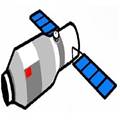题目内容

China launched its first space lab module Tiangong-1 on the evening of September 29, 2011, at the Jiuquan Satellite Launch Center in northwestern China.
President Hu Jintao praised the successful launch of China's first space lab module Tiangong-1, and shook hands with the staff of the Beijing Aerospace Flight Control Center.
Premier Wen Jiabao and He Guoqiang also shook hands with the staff at the Jiuquan Satellite Launch Center to congratulate on the success.
Tiangong-1, which is scheduled to dock(与……对接) with the Shenzhou-8 spacecraft later this year, will pave the way for building China's first space station.
During its two-year service life, Tiangong-1 will mainly conduct four tasks, such as experiments of autonomous rendezvous(自主交会) and docking procedures(程序) with the Shenzhou-8, -9, and -10 spacecrafts in the coming launches, aiming to establish the country's first space lab, according to Wu Ping, spokesperson for China's national space administration.
According to the plan for China's manned space program, the Shenzhou-10 will be a manned spacecraft, possibly carrying a female Chinese astronaut who will test manual space rendezvous and docking with the Tiangong-1.
Functioning as a target spacecraft, Tiangong-1 is expected to become China's first space laboratory when it connects to the above mentioned spaceships
- 1.
When Tiangong-1 was launched, _____were at the Jiuquan Satellite Launch Center
- A.Premier Wen Jiabao and He Guoqiang
- B.Premier Wen Jiabao and President Hu Jintao
- C.He Guoqiang and President Hu Jintao
- D.President Hu Jintao and some staff
- A.
- 2.
It is reported that Tiangong-1 will conduct _____ tasks during its service life
- A.two
- B.three
- C.four
- D.five
- A.
- 3.
The underlined word “establish” here means _____________
- A.prepare
- B.build
- C.discover
- D.use
- A.
- 4.
The _____ spacecraft will be carrying a female Chinese astronaut
- A.Shenzhou-7
- B.Shenzhou-8
- C.Shenzhou-9
- D.Shenzhou-10
- A.
- 5.
Which of the following is WRONG according to the passage?
- A.Tiangong-1 was launched in the evening
- B.The service life of Tiangong-1 is about two years
- C.China expects Tiangong-1 to be the first space lab
- D.Tiangong-1 will dock with the Shenzhou-8 spacecraft next year
- A.
1.细节理解题,根据文中第二第三自然段的语句理解可知。
2.细节理解题,根据文中语句“During its two-year service life, Tiangong-1 will mainly conduct four tasks,”理解可知。
3.细节理解题,根据文中第五自然段的语句理解可知。
4.细节理解题,根据文中语句“the Shenzhou-10 will be a manned spacecraft, possibly carrying a female Chinese astronaut who will test manual space rendezvous and docking with the Tiangong-1.”理解可知。
5.细节理解题,根据文中语句“Tiangong-1, which is scheduled to dock(与……对接) with the Shenzhou-8 spacecraft later this year, will pave the way for building China's first space station.”理解可知。

 导学与测试系列答案
导学与测试系列答案 新非凡教辅冲刺100分系列答案
新非凡教辅冲刺100分系列答案Two Chinese spacecrafts successfully completed China’s first space docking early November 3, 2011, which has taken the country a step closer to building its own space station.
Nearly two days after its launch, the unmanned spacecraft Shenzhou VIII docked with the space lab module Tiangong I more than 343 km above the earth surface. Shenzhou VIII and Tiangong I took apart after flying together for 12 days. On the 14th of November, the two spacecrafts finished the second docking. Then Shenzhou VIII parted from Tiangong I again and returned to the earth safely on the 17th. Tiangong I is still traveling around the earth in the space, waiting for the arrival of Shenzhou IX and X and so on in the near future.
That marked another great leap for China’s space program and made China the third country in the world, after the United States and Russia, to master the space docking technique (空间对接技术).
The world’s first space docking was achieved in 1966, when the manned U.S, spacecraft Gemini 8 (双子星8号) docked with an unmanned Agena Target Vehicle (阿金纳目标飞行器). Space docking is necessary to explore space beyond Earth’s orbit. “The capability increases China’s ability to act independently in space, as well as its ability to work together with others,” said Gregory Kulacki, a U.S. space scientist and senior analyst.
“With the success of its first space docking, China is now equipped with the basic technology and ability required for the construction of a space station,” said Zhou Jianping, chief designer of China’s manned space program.” The country is on its way to building a permanent manned space station around 2020.”
【小题1】What did the success of the first space docking mean to China?
| A.China has caught up with the United States in the space exploration field. |
| B.China took a step closer to building its own space station. |
| C.China became the first country to master the space docking technique. |
| D.China has the ability to build a permanent manned space station right now. |
| A.Shenzhou VIII. |
| B.Tiangong I |
| C.The Space Station |
| D.The success of China’s first space docking |
| A.Tiangong I will fly in the space for 12 days. |
| B.The first space docking of the world was achieved in 1966, by Russians. |
| C.Without space docking technique people can’t explore space beyond Earth’s orbit. |
| D.The U.S.A helped China achieve the first space docking. |
| A.The first space docking of China. |
| B.The history of space docking. |
| C.The first space docking of the world. |
| D.The space docking technique |

China launched its first space lab module Tiangong-1 on the evening of September 29, 2011, at the Jiuquan Satellite Launch Center in northwestern China.
President Hu Jintao praised the successful launch of China's first space lab module Tiangong-1, and shook hands with the staff of the Beijing Aerospace Flight Control Center.
Premier Wen Jiabao and He Guoqiang also shook hands with the staff at the Jiuquan Satellite Launch Center to congratulate on the success.
Tiangong-1, which is scheduled to dock(与……对接) with the Shenzhou-8 spacecraft later this year, will pave the way for building China's first space station.
During its two-year service life, Tiangong-1 will mainly conduct four tasks, such as experiments of autonomous rendezvous(自主交会) and docking procedures(程序) with the Shenzhou-8, -9, and -10 spacecrafts in the coming launches, aiming to establish the country's first space lab, according to Wu Ping, spokesperson for China's national space administration.
According to the plan for China's manned space program, the Shenzhou-10 will be a manned spacecraft, possibly carrying a female Chinese astronaut who will test manual space rendezvous and docking with the Tiangong-1.
Functioning as a target spacecraft, Tiangong-1 is expected to become China's first space laboratory when it connects to the above mentioned spaceships.
【小题1】When Tiangong-1 was launched, _____were at the Jiuquan Satellite Launch Center.
| A.Premier Wen Jiabao and He Guoqiang |
| B.Premier Wen Jiabao and President Hu Jintao |
| C.He Guoqiang and President Hu Jintao |
| D.President Hu Jintao and some staff |
| A.two | B.three | C.four | D.five |
| A.prepare | B.build | C.discover | D.use |
| A.Shenzhou-7 | B.Shenzhou-8 |
| C.Shenzhou-9 | D.Shenzhou-10 |
| A.Tiangong-1 was launched in the evening. |
| B.The service life of Tiangong-1 is about two years. |
| C.China expects Tiangong-1 to be the first space lab. |
| D.Tiangong-1 will dock with the Shenzhou-8 spacecraft next year. |
Shenzhou X and three astronauts(宇航员) were sent up from Jiuquan Satellite Launch Center, Gansu province, into a clear blue sky on Tuesday, bringing the nation one step closer to building its own space(太空) station in 2020.
Two men, mission commander(指挥官) Nie Haisheng and Zhang Xiaoguang, and China’s second female astronaut, Wang Yaping, are expected to stay in space for 15 days.
They will teach young people about science and do two space dockings, between Shenzhou X and the unmanned Tiangong-1 space module, a technically difficult procedure that brings two spaceship together in high-speed orbit(轨道).
The trip is our country’s fifth manned space mission, 10 years after the country’s first astronaut, Yang Liwei, went into space in 2003.
【小题1】How long will they stay in space?
| A.About a week | B.About two weeks | C.About a month | D.About two months |
| A.teach young people about science | B.take some photos |
| C.do two space dockings | D.Both A and C |
| A.太空实验 | B.太空对接 | C.太空垃圾 | D.太空站 |
| A.Nie Haisheng | B.Zhang Xiaoguang | C.Wang Yaping | D.Yang Liwei |